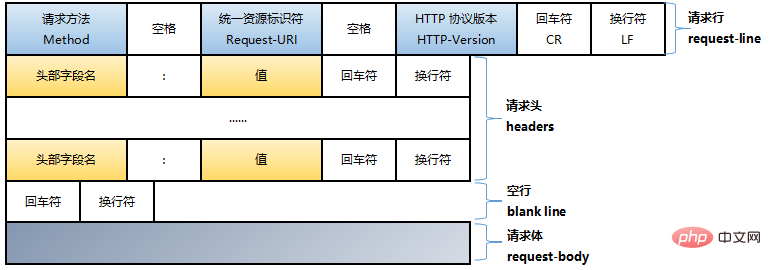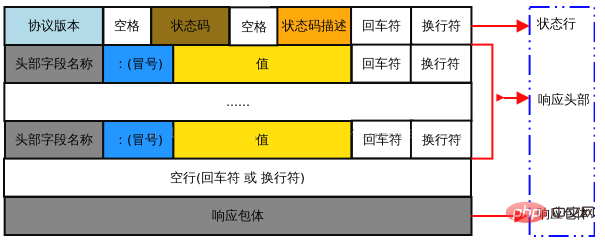Swoole与HTTP

目标
- 了解swoole的http_server的使用
- 了解swoole的tcp服务开发
- 实际项目中问题如粘包处理、代理热更新、用户验证等。
swoole与现有框架结合
推荐(免费):swoole
风格
- 偏基础重代码
环境
- PHP版本:
- Swoole版本:https://github.com/swoole/swoole-src
- zphp开发框架:https://github.com/shenzhe/zphp
HTTP Server
- 静态文件处理
- 动态请求与框架结合
# 查看SWOOLE版本 $ php -r 'echo SWOOLE_VERSION;' 4.3.1
基础概念
HTTP报文
关于HTTP请求报文的组成结构

HTTP请求报文结构
POST /search HTTP/1.1 Accept: image/gif, image/x-xbitmap, image/jpeg, image/pjpeg, application/vnd.ms-excel, application/vnd.ms-powerpoint, application/msword, application/x-silverlight, application/x-shockwave-flash, */* Referer: http://www.google.cn/ Accept-Language: zh-cn Accept-Encoding: gzip, deflate User-Agent: Mozilla/4.0 (compatible; MSIE 6.0; Windows NT 5.1; SV1; .NET CLR 2.0.50727; TheWorld) Host: www.google.cn Connection: Keep-Alive Cookie: PREF=ID=80a06da87be9ae3c:U=f7167333e2c3b714:NW=1:TM=1261551909:LM=1261551917:S=ybYcq2wpfefs4V9g; NID=31=ojj8d-IygaEtSxLgaJmqSjVhCspkviJrB6omjamNrSm8lZhKy_yMfO2M4QMRKcH1g0iQv9u-2hfBW7bUFwVh7pGaRUb0RnHcJU37y- FxlRugatx63JLv7CWMD6UB_O_r hl=zh-CN&source=hp&q=domety
关于HTTP响应报文的组成结构

HTTP响应报文结构
HTTP/1.1 200 OK Date: Mon, 23 May 2005 22:38:34 GMT Content-Type: text/html; charset=UTF-8 Content-Encoding: UTF-8 Content-Length: 138 Last-Modified: Wed, 08 Jan 2003 23:11:55 GMT Server: Apache/1.3.3.7 (Unix) (Red-Hat/Linux) ETag: "3f80f-1b6-3e1cb03b" Accept-Ranges: bytes Connection: close
创建HTTP服务器
Swoole在1.7.7版本后内置HTTP服务器,可创建一个异步非阻塞多进程的HTTP服务器。Swoole的HTTP服务器对HTTP协议支持的并不完整,建议仅作为应用服务器,并在前端增加Nginx作为代理。
因为Swoole是在CLI命令行中执行的,在传统的NGINX+FastCGI模式下很多root的shell是无法执行的,而使用Swoole服务器就能很好的控制rsync、git、svn等。
使用Swoole的API,构建HTTP服务器需要4个步骤
- 创建Server对象
- 设置运行时参数
- 注册事件回调函数
- 启动服务器
# 创建应用 $ mkdir test && cd test # 创建并编辑服务器文件 $ vim server.php
<?php
//创建HTTP服务器对象
$host = "0.0.0.0";
$port = 9501;
$server = new swoole_http_server($host, $port);
var_dump($server);
//设置服务器运行参数
$configs = [];
$configs["worker_num"] = 2;//设置Worker工作进程数量
$configs["daemonize"] = 0;//设置是否已后台守护进程运行
$server->set($configs);
//注册监听客户端HTTP请求回调事件
$server->on("request", function(swoole_http_request $request, swoole_http_response $response) use($server){
var_dump($request);
var_dump($response);
//获取客户端文件描述符
$fd = $request->fd;
if(!empty($fd)){
//获取连接信息
$clientinfo = $server->getClientInfo($fd);
var_dump($clientinfo);
//获取收包时间
var_dump($clientinfo["last_time"]);
}
//响应客户端HTTP请求
$response->write("success");//向客户端写入响应数据
$response->end();//浏览器中输出结果
});
//启动服务器
$server->start();# 使用PHP-CLI运行服务器脚本 $ php server.php # 使用CURL向HTTP服务器发送请求测试 $ curl 127.0.0.1:9501
使用注意
-
echo、var_dump、print_r的内容是在服务器中输出的 - 浏览器中输出需要使用
$rp->end(string $contents),end()方法只能调用一次。 - 如果需要多次先客户端发送消息可使用
$rp->write(string $content)方法 - 完整的HTTP协议请求会被解析并封装在
swoole_http_request对象中 - 所有的HTTP协议响应会通过
swoole_http_response对象进行封装并发送
HTTP服务器的本质
由于swoole_http_server是基于swoole_server的,所以swoole_server下的方法在swoole_http_server中都可以使用,只是swoole_http_server只能被客户端唤起。简单来说,swoole_http_server是基于swoole_server加上HTTP协议,再加上request和response类库去实现请求数据和获取数据。与PHP-FPM不同的是,Web服务器收到请求后会传递给Swoole的HTTP服务器,直接返回请求。

swoole_http_server
Http\Server
Swoole\HTTP\Server继承自Server,是一个HTTP服务器实现,支持同步与有异步两种模式。无论是同步模式还是异步模式,HTTP服务器都可以维持大量的TCP客户端连接,同步与异步仅仅提现在对请求的处理方式。
- 同步模式
同步模式等同于Nginx+PHP-FPM/Apache,需要设置大量Worker工作进程来完成并发请求处理,Worker工作进程可以使用同步阻塞IO,编程方式与普通的PHP的Web程序完全一致。与PHP-FPM/Apache不同的是,客户端连接并不会独占进程,服务器依然可以应对大量并发连接。
- 异步模式
异步模式下整个HTTP服务器是异步非阻塞的,服务器可以应答大规模的并发连接和并发请求,编程方式需要完全使用异步API,如MySQL、Redis、HTTP客户端、file_get_contents、sleep等阻塞IO操作必须切换为异步方式,如异步Client、Event、Timer等API。
查看HTTP服务器实例对象
var_dump($server);
object(Swoole\Connection\Iterator)#2 (0) {
["host"]=>string(7) "0.0.0.0"
["port"]=>int(9501)
["type"]=>int(1)
["mode"]=>int(2)
["ports"]=>
array(1) {
[0]=>
object(Swoole\Server\Port)#3 (16) {
["onConnect":"Swoole\Server\Port":private]=>NULL
["onReceive":"Swoole\Server\Port":private]=>NULL
["onClose":"Swoole\Server\Port":private]=>NULL
["onPacket":"Swoole\Server\Port":private]=>NULL
["onBufferFull":"Swoole\Server\Port":private]=>NULL
["onBufferEmpty":"Swoole\Server\Port":private]=>NULL
["onRequest":"Swoole\Server\Port":private]=>NULL
["onHandShake":"Swoole\Server\Port":private]=>NULL
["onOpen":"Swoole\Server\Port":private]=>NULL
["onMessage":"Swoole\Server\Port":private]=>NULL
["host"]=>string(7) "0.0.0.0"
["port"]=>int(9501)
["type"]=>int(1)
["sock"]=>int(4)
["setting"]=>NULL
["connections"]=>object(Swoole\Connection\Iterator)#4 (0) {
}
}
}
["master_pid"]=>int(0)
["manager_pid"]=>int(0)
["worker_id"]=>int(-1)
["taskworker"]=>bool(false)
["worker_pid"]=>int(0)
["onRequest":"Swoole\Http\Server":private]=>NULL
["onHandshake":"Swoole\Http\Server":private]=>NULL
}配置选项
文件上传upload_tmp_dir
HTTP服务器支持大文件上传,但由于Swoole底层的限制,文件内容是存放在内存中的,因此如果并发上传大量文件可能会导致内存占用量过大的问题。
可以修改upload_tmp_dir选项用于配置上传文件的临时目录,需要注意是目录文件夹的名称最大长度不得超过220个字节。
$configs = []; $configs["upload_tmp_dir"] = "/data/uploads/"; $server->set($configs);
POST解析http_parse_post
可通过修改http_parse_post配置项用来设置表单POST提交后是否解析,若设置为true则表示会自动将Content-Type内容类型为x-www-urlencode的请求包体解析到 POST 数组,若设置为false则表示将会关闭 POST解析。
$configs = []; $configs["http_parse_post"] = true; $server->set($configs);
POST尺寸 package_max_length
默认情况下,表单上传或POST提交2MB的数据的限制,可通过修改package_max_length选项调整POST尺寸大小。
$configs = []; $configs["package_max_length"] = 2*1024; $server->set($configs);
解析Cookiehttp_parse_cookie
通过修改http_parse_cookie配置项可以开启或关闭Cookie解析,关闭后将会在Header头信息学中保留未经处理的原始Cookies信息。
$configs = []; $configs["http_parse_cookie"] = true; $server->set($configs);
文件压缩http_compression
http_compression适用于Swoole4.1.0+版本,用于启用或关闭对HTTP信息的压缩,默认为开启状态。
由于http-chunk不支持分段独立压缩,因此默认已强制关闭了压缩功能。
$configs = []; $configs["http_compression"] = false; $server->set($configs);
目前HTTP支持gzip、br(需google brotli库支持)、deflate三种压缩格式,Swoole底层会根据客户端浏览器传入的Accept-Encoding头信息自动选择压缩方式。
压缩级别http_compression_level
http_compression_level选项用于配置压缩的级别,压缩级别越高压缩后体积越小,同时也会越占用CPU。
$configs = []; $configs["http_compression_level"] = 1; $server->set($configs);
静态根目录document_root
document_root选项适用于Swoole1.9.17+版本,用于配置静态文件的根目录,该功能由于较为简易不推荐在公网环境下直接使用,常于enable_static_handler选项配合使用。
如果设置document_root和enable_static_handler = true后,Swoole底层收到HTTP请求时会先判断document_root的路径下是否存在某静态文件,如果存在会直接发送内容给客户端,并不再调用onRequest函数。
这里需要注意的时,在使用静态文件处理特性时,应当将动态PHP代码于静态文件进行隔离,静态文件应存放到特定的目录下。
$configs = []; $configs["document_root"] = "/app"; $server->set($configs);
静态处理 enable_static_handler
enable_static_handler选项用于开启或关闭静态文件请求处理功能,常配合document_root选项使用。
$configs = []; $configs["enable_static_handler"] = true; $server->set($configs);
静态处理器路径static_handler_locations
static_handler_location选项适用于Swoole4.4.0+版本,用于设置静态处理器的路径,类型为数组,默认不启用。
静态处理器类似于Nginx的location指令,可以指定一个或多个路径为静态路径。只有URL在指定路径下才会启用静态问而建处理器,否则会视为动态请求。location选项必须以/开头并支持多级路径,如/app/images。
当启用static_handler_locations选项后,如果请求对应的文件不存在,将直接会返回404错误。
$configs = []; $configs["static_handler_locations"] = ["/static", "/public/assets"]; $server->set($configs);
设置代理
由于swoole_http_server对HTTP协议支持的并不完整,建议仅仅作为应用服务器,并在前端增加Nginx作为反向代理。
操作前需要修改服务器的运行参数,设置enable_static_handle为true后,底层收到HTTP请求会像判断document_root路径下是否存在目标文件,若存在则会直接发送文件给客户端,不再触发onRequest回调。
- 设置服务器运行时环境
$ vim server.php
$configs = []; $configs["enable_static_handler"] = true; $configs["document_root"] = "/test"; $server->set($configs);
- 设置Nginx反向代理配置
例如:设置Nginx反向代理127.0.0.1:9501
$ vim /usr/local/nginx/conf/nginx.conf
http {
include mime.types;
default_type application/octet-stream;
#log_format main '$remote_addr - $remote_user [$time_local] "$request" '
# '$status $body_bytes_sent "$http_referer" '
# '"$http_user_agent" "$http_x_forwarded_for"';
#access_log logs/access.log main;
sendfile on;
#tcp_nopush on;
#keepalive_timeout 0;
keepalive_timeout 65;
#gzip on;
upstream swoole{
server 127.0.0.1:9501;
keepalive 4;
}
server {
listen 80;
server_name www.swoole.com;
#charset koi8-r;
#access_log logs/host.access.log main;
location / {
proxy_pass http://swoole;
proxy_set_header Connection "";
proxy_http_version 1.1;
root html;
index index.html index.htm;
}
#error_page 404 /404.html;
# redirect server error pages to the static page /50x.html
error_page 500 502 503 504 /50x.html;
location = /50x.html {
root html;
}
}Nginx+Swoole的组合中Nginx反向代理的配置
server {
root /data/wwwroot/;
server_name local.swoole.com;
location / {
proxy_http_version 1.1;
proxy_set_header Connection "keep-alive";
proxy_set_header X-Real-IP $remote_addr;
if (!-e $request_filename) {
proxy_pass http://127.0.0.1:9501;
}
}
}请求对象
swoole_http_request请求对象保存了HTTP客户端请求的相关信息,包括GET、POST、COOKIE、Header等,请求对象$request销毁时会自动删除上传的临时文件,不要使用&符号引用$request请求对象。
var_dump($request);
object(Swoole\Http\Request)#6 (10) {
["fd"]=>int(1)
["streamId"]=>int(0)
["header"]=>array(3) {
["host"]=>string(14) "127.0.0.1:9501"
["user-agent"]=>string(11) "curl/7.52.1"
["accept"]=>string(3) "*/*"
}
["server"]=>array(10) {
["request_method"]=>string(3) "GET"
["request_uri"]=>string(1) "/"
["path_info"]=>string(1) "/"
["request_time"]=>int(1561689532)
["request_time_float"]=>float(1561689533.0563)
["server_port"]=>int(9501)
["remote_port"]=>int(51188)
["remote_addr"]=>string(9) "127.0.0.1"
["master_time"]=>int(1561689532)
["server_protocol"]=>string(8) "HTTP/1.1"
}
["request"]=>NULL
["cookie"]=>NULL
["get"]=>NULL
["files"]=>NULL
["post"]=>NULL
["tmpfiles"]=>NULL
}Http\Request->$header
HTTP请求的头部信息,类型为数组,所有的键名均为小写。
$host = $request->header["host"]; $accept = $request->header["accept"];
Http\Request->$server
HTTP请求相关的服务器信息,相当于PHP的$_SERVER全局数组,包含了HTTP请求的方法、URL路径、客户端IP等信息。服务器信息为关联数组,数组中的键名全部小写,并且与PHP的$_SERVER数组保持一致。
$request_method = $request->server["request_method"]; $request_time = $request->server["request_time"]; $request_uri = $request->server["request_uri"];
请求路径
当Google的Chrome浏览器访问服务器是会产生两次请求,这是因为Chrome会自动请求一次favicon.ico文件,所以服务器会收到两个HTTP请求,通过打印$request->server["request_uri"]可以查看到请求URL路径。如果需要屏蔽掉对favicon.ico的请求,可采用以下方式。
$uri = $request->server["request_uri"];
if($uri == "/favicon.icon")
{
$respoonse->status(404);
$response->end();
}收包时间
request_time请求时间是在Worker工作进程中设置的,在SWOOLE_PROCESS多进程模式下存在dispatch分发的过程,因此可能会与实际收包时间存在偏差,尤其当请求量超过服务器处理能力时,有可能滞后于实际收包时间。
可通过Server->getClientInfo()方法获取last_time以获取 准确的收包时间。
//获取客户端文件描述符
$fd = $request->fd;
if(!empty($fd)){
//获取连接信息
$clientinfo = $server->getClientInfo($fd);
var_dump($clientinfo);
//获取收包时间
var_dump($clientinfo["last_time"]);
}客户端信息
Server->getClientInfo()用于获取连接的客户端信息
bool|array Server->getClientInfo(int $fd, int $extraData, bool $ignoreError = false)
-
int $fd表示客户端连接文件描述符 -
int $extraData表示扩展信息是保留参数目前无任何效果 -
bool $ignoreError表示是否忽略错误,若设置为true表示即使连接关闭也会返回连接信息。
如果传入的$fd客户端连接文件描述符存在则返回一个数组,若不存在或已关闭则返回false。
array(10) {
["server_port"]=>int(9501)
["server_fd"]=>int(4)
["socket_fd"]=>int(12)
["socket_type"]=>int(1)
["remote_port"]=>int(51194)
["remote_ip"]=>string(9) "127.0.0.1"
["reactor_id"]=>int(0)
["connect_time"]=>int(1561690606)
["last_time"]=>int(1561690606)
["close_errno"]=>int(0)
}Http\Request->$get
HTTP请求的GET参数,相当于PHP中的$_GET,格式为键值对的关联数组。为防止HASH攻击,GET参数最大不允许超过128个。
$get = $request->get;//获取HTTP请求的所有GET参数
HTTP的GET请求只有一个HTTP Header头,Swowole底层使用固定大小的内存缓冲区为8K,而且不可修改。如果请求不是正确的HTTP请求,将会出现错误,底层会抛出错误。
WARN swReactorThead_onReceive_http_request: http header is too long.
Http\Request->$post
HTTP请求携带POST参数,格式为键值对的关联数组,POST与Header加起来的尺寸不得超过package_max_length的设置,否则会认为是恶意请求,另外POST参数的个数不得超过128个。
$post = $request->post;
由于POST文件上传时最大尺寸收到package_max_length配置项目的限制,默认为2MB,可以调用swoole_server->set传入新值修改尺寸。
由于Swoole底层是全内存的,因此如果设置过大可能会导致大量并发请求,将服务器资源耗尽。
设置计算方法:最大内存占用 = 最大并发请求数量 * package_max_length
当使用CURL发送POST请求时服务器端会超时
CURL在发送较大的POST请求时会首先发送一个100-continue的请求,当收到服务器的回应才会发送实际的POST数据。然后swoole_http_server并不支持100-continue,因此会导致CURL请求超时。解决的办法时关闭CURL的100-continue。
$ch = curl_init(); curl_setopt($ch, CURLOPT_URL, $url); curl_setopt($ch, CURLOPT_HEADER, 0); curl_setopt($ch, CURLOPT_POST, 1);//设置为POST方式 curl_setopt($ch, CURLOPT_HTTPHEADER, ["Exception:"]); curl_setopt($ch, CURLOPT_POSTFIELDS, $data); curl_setopt($ch, CURLOPT_RETURNTRANSFER, true);
Http\Request->$cookie
HTTP请求携带的COOKIE信息,格式为键值对的关联数组。
Http\Request->$files
HTTP请求携带的文件上传信息,类型为以form表单名称为key键名的二维数组,与PHP原生的$_FILES相同,最大文件尺寸不得超过package_max_length中设置的值,不要使用Swoole\Http\Server处理大文件上传。
$files = $request->files; var_dump($files);
array(5) {
[name] => facepalm.jpg
[type] => image/jpeg
[tmp_name] => /tmp/swoole.upfile.n3FmFr
[error] => 0
[size] => 15476
}-
name表示浏览器上传时传入的文件名称 -
type表示浏览器上传时的MIME类型 -
tmp_name表示浏览器上传的临时文件,文件名默认以/tmp/swoole.upfile开头。 -
size表示上传文件的尺寸
Swoole1.9.10+版本支持is_uploaded_file和move_uploaded_file函数。当HTTP请求对象$request对象销毁时,会自动删除上传的临时文件。
Http\Request->rawContent()
rawContent表示获取原始的POST包体,用于非application/x-www-form-urlencode格式的HTTP的POST请求。等同于原生PHP的fopen("php://input"),有时服务器不需要解析HTTP的POST请求参数。
Swoole1.7.18+版本增加了http_parse_post配置用于关闭或开启POST数据解析。
string HTTP\Request->rawContent();
Http\Request->getData()
getData()方法用于获取完整的HTTP请求报文,包括 Http Header和`HTTP Body消息体。
function swoole_http_request_getData() : string
getData需要Swoole1.10.3或Swoole2.1.2或更高的版本。
响应对象
swoole_http_response响应对象是进程隔离的,不能跨越进程或对象。如果是当前进程中,想使用fd文件描述符保存response响应对象、存储上下文,可使用PHP全局数组变量来保存。
swoole_http_response响应对象,通过调用此对象的方法实现HTTP响应的发送,当响应对象销毁时,如果没有调用end发送HTTP响应,底层会自动执行end方法。不要使用&符号引用$response对象。
object(Swoole\Http\Response)#7 (4) {
["fd"]=>int(1)
["header"]=>NULL
["cookie"]=>NULL
["trailer"]=>NULL
}HTTP服务器Response响应对象,通过调过此对象的方法,实现HTTP响应发送。当Response对象销毁时,如果未调用则直接调用end方法,不要使用&符号引用$response对象。
Http\Response->header
function Http\Response->header( string $key, string $value, bool $ucworods = true )
header方法用于设置HTTP响应的Header头信息,如果设置失败返回false,设置成功则无返回值。
-
string $key表示HTTP头的Key -
string $value表示HTTP头的Value -
bool $ucwords表示是否需要对Key进行HTTP约定格式化,默认true会自动格式化。
$response->header("Content-Type", "image/jpeg", true);
跨域处理
$origin = $request->header['origin'];
// Access-Control-Allow-Origin 不能使用 *,这样修改是不支持php版本低于7.0的。
// $response->header('Access-Control-Allow-Origin', '*');
$response->header('Access-Control-Allow-Origin', $origin);
$response->header('Access-Control-Allow-Methods', 'OPTIONS');
$response->header('Access-Control-Allow-Headers', 'x-requested-with,session_id,Content-Type,token,Origin');
$response->header('Access-Control-Max-Age', '86400');
$response->header('Access-Control-Allow-Credentials', 'true');
if ($request->server['request_method'] == 'OPTIONS') {
$response->status(200);
$response->end();
return;
};Http\Response->cookie
cookie方法用来设置HTTP响应的Cookie信息,方法参数与原生PHP的setcookie函数完全一致。
function Http\Response->cookie( string $key, string $value = "", int $expire = 0, string $path = "/", string $domain = "", bool $secure = false, bool $httponly = false )
Cookie设置必须在end方法之前方才生效,Swoole底层自动会对$value进行urlencode编码处理,同时允许设置多个相同的$key的Cookie。
Http\Response->status
swoole_http_response->status( int $http_status_code )
status方法用于发送HTTP状态码,$http_status_code必须是合法的HTTP状态码,如2xx、3xx、4xx、5xx等,若不是在会报错,另外status方法也必须在$response->end()之前执行方才生效。
-
string $url表示跳转的新地址会作为HTTP Header头中的Location选项进行发送 -
int $http_code表示状态码,默认为302临时跳转,传入301表示永久跳转。
Http\Response->redirect
redirect方法适用于Swoole2.2.0+版本,用于发送HTTP跳转,调用后会自动执行end方法并发送结束响应。
function Http\Response->redirect( string $url, int $http_code = 302 )
例如
$server = new swoole_http_server("0.0.0.0", 9501, SWOOLE_BASE);
$server->on("request", function(swoole_http_request $request, swoole_http_response $response){
$url = "http://www.baidu.com";
$response->redirect($url, 301);
});
$server->start();Http\Response->write
write方法用于启用HTTP的chunk分段以向浏览器发送相应的内容,使用write分段发送数据后end方法将不再接收任何参数,调用end方法后会发送一个长度为0的分段chunk表示数据传输完毕。
bool Http\Response->write(string $data)
参数$data表示要发送的数据内容,最大长度不得超过2MB,受buffer_output_size配置项控制。
Http\Response->sendfile
sendfile用于发送文件到浏览器
function Http\Response->sendfile( string $filename, int $offset = 0, int $length = 0 )
-
string $filename表示要发送的文件名称,文件不存在或没有访问权限则会发送失败。 -
int $offset表示上传文件的偏移量,可以指定从文件在中间部分开始传输数据,用于断点续传,适用于Swoole1.9.11+。 -
int $length表示发送数据的尺寸,默认为整个文件的尺寸,适用于Swoole1.9.11+。
$response->header("Content-Type", "image/jpeg"); $filepath = $request->server["request_uri"]; $filename = __DIR__.$filepath; $response->sendfile($filename);
由于Swoole底层无法推断要发送文件的媒体类型MIME格式,因此需要应用程序指定Content-Type。调用sendfile前不得使用write方法发送HTTP数据段Chunk,调用sendfile后Swoole底层会自动执行end方法,另外sendfile不支持gzip压缩。
Http\Response->end
end方法用于发送HTTP响应体,并结束请求处理。
function Http\Response->end(string $html);
end方法只能调用一次,如果需要分多次向客户端发送数据下需使用write方法,send操作后将会向客户端浏览器发送HTML内容。如果客户端开启了KeepAlive连接会保持,服务器会等待下一次请求。如果没有开启KeepAlive服务器将会切断连接。
Http\Response->detach
detach表示分离响应对应,调用后$response对象销毁时将不会自动执行end方法,一般detach会与Http\Response::create以及Server::send配合使用,适用于Swoole2.2.0+版本。
function Http\Response->detach():bool
detach方法操作后,若客户端已经完成响应则会返回true,否则返回false。
detach应用于跨进程响应
在某些情况下需要在Task任务进程中对客户端发出响应,此时可以利用detach方法使$response对象独立,如此一来在Task任务进程中就可以重新构建$response对象以发起HTTP请求响应。
<?php
//创建HTTP服务器对象
$host = "0.0.0.0";
$port = 9501;
$server = new swoole_http_server($host, $port);
//设置服务器运行参数
$configs = [];
$configs["worker_num"] = 1;//设置Worker工作进程数量
$configs["task_worker_num"] = 1;//设置Task任务进程数量
$configs["daemonize"] = 0;//设置是否已后台守护进程运行
$server->set($configs);
//注册客户端请求处理回调函数
$server->on("request", function(swoole_http_request $request, swoole_http_response $response) use($server){
//分离响应对象
$response->detach();
//在Task任务进程中对客户端发出响应
$fd = strval($response->fd);
$server->task($fd);
});
//注册异步任务处理回调函数
$server->on("task", function(swoole_http_server $server, $worker_id, $data){
//创建响应对象
$response = swoole_http_response::create($data);
//向客户端发送响应
$html = "in task";
$response->end($html);
});
//注册Task异步任务执行完毕回调函数
$server->on("finish", function(){
echo "[finish] task".PHP_EOL;
});
//启动服务器
$server->start();detach方法应用于发送任意内容
在某些特殊场景下,需要对客户端发送特殊的响应内容,Http\Response对象自带的end方法无法满足需求,可以使用detach方法分离响应对象,然后自行组包并使用Server::send方法发送数据。
<?php
//创建HTTP服务器对象
$host = "0.0.0.0";
$port = 9501;
$server = new swoole_http_server($host, $port);
//设置服务器运行参数
$configs = [];
$configs["worker_num"] = 2;//设置Worker工作进程数量
$configs["daemonize"] = 0;//设置是否已后台守护进程运行
$server->set($configs);
//注册监听客户端HTTP请求回调事件
$server->on("request", function(swoole_http_request $request, swoole_http_response $response) use($server){
//分离响应对象
$response->detach();
//自行组包并使用Server::send方法发送数据
$fd = $response->fd;
$message = "HTTP/1.1 200 OK\r\n";
$message .= "Server: server\r\n";
$message .= "\r\n";
$message .= "Hello World\n";
$server->send($fd, $message);
});
//启动服务器
$server->start();Http\Response::create
create静态方法用于构造新的Http\Response响应对象,使用前必须调用detach方法将旧有$response对象分离,否则 可能会造成同一个请求发送两次响应内容。
function Http\Response::createE(int $fd) : Http\Response
create静态方法的参数$fd表示需要绑定连接的文件描述符,调用Http\Response对象的end方法和write方法时会向此连接发送数据。如果调用成功则返回一个新的Http\Response对象,否则失败返回false,适用于Swoole2.2.0+版本。
注册事件回调函数
Http\Server注册事件回调函数于Http\Server->on相同,不同之处在于HTTP\Server->on不接受onConnect和onReceive回调设置,Http\Server->on会额外接受一种新的事务类型onRequest。
onRequest 事件
onRequest事件适用于Swoole1.7.7+版本,当服务器收到一个完整的HTTP请求后会调用onRequest函数。
$server->on("request", function(swoole_http_request $request, swoole_http_response $response) use($server){
$html = "success";
$response->end($html);
});onRequest回调函数共有两个参数
-
swoole_http_requst $requestHTTP请求信息对象,包含了Header/GET/POST/Cookie等信息。 -
swoole_http_response $responseHTTP响应信息对象,支持Cookie/Header/Status等HTTP操作。
在onRequest回调函数返回时会销毁$request和$response对象,如果未执行$response->end()操作,Swoole底层会自动执行一次$response->end("")。
$request和$response对象在传递给其它函数时,是不需要添加&取地址的引用符号的,传递后引用计数会增加,当onRequest退出时并不会被销毁。
案例
$ vim http_server.php
<?php
$addr = "0.0.0.0";
$port = 9501;
$svr = new swoole_http_server($addr, $port);
$svr->on("request", function(swoole_http_request $rq, swoole_http_response $rp){
//处理动态请求
$path_info = $rq->server["path_info"];
$file = __DIR__.$path_info;
echo "\nfile:{$file}";
if(is_file($file) && file_exists($file)){
$ext = pathinfo($path_info, PATHINFO_EXTENSION);
echo "\next:{$ext}";
if($ext == "php"){
ob_start();
include($file);
$contents = ob_get_contents();
ob_end_clean();
}else{
$contents = file_get_contents($file);
}
echo "\ncontents:{$contents}";
$rp->end($contents);
}else{
$rp->status(404);
$rp->end("404 not found");
}
});
$svr->start();# 创建静态文件 $ vim index.html index.html # 测试静态文件 $ curl 127.0.0.1:9501/index.html # 观察http_server输出 file:/home/jc/projects/swoole/chat/index.html ext:html contents:index.html # 测试动态文件 $ vim index.php <?php echo "index.php"; #观察http_server日志输出 file:/home/jc/projects/swoole/chat/index.php ext:php contents:index.php
获取动态请求的参数
$ vim http_server.php
<?php
$addr = "0.0.0.0";
$port = 9501;
$svr = new swoole_http_server($addr, $port);
$svr->on("request", function(swoole_http_request $rq, swoole_http_response $rp){
//获取请求参数
$params = $rq->get;
echo "\nparams:".json_encode($params);
//处理动态请求
$path_info = $rq->server["path_info"];
$file = __DIR__.$path_info;
echo "\nfile:{$file}";
if(is_file($file) && file_exists($file)){
$ext = pathinfo($path_info, PATHINFO_EXTENSION);
echo "\next:{$ext}";
if($ext == "php"){
ob_start();
include($file);
$contents = ob_get_contents();
ob_end_clean();
}else{
$contents = file_get_contents($file);
}
echo "\ncontents:{$contents}";
$rp->end($contents);
}else{
$rp->status(404);
$rp->end("404 not found");
}
});
$svr->start();测试带参数的请求
$ curl 127.0.0.1:9501?k=v
观察请求参数的输出
params:{"k":"v"}
file:/home/jc/projects/swoole/chat/index.html
ext:html
contents:index.html静态文件处理
$ vim mimes.php
<?php
return [
"jpg"=>"image/jpeg",
"jpeg"=>"image/jpeg",
"bmp"=>"image/bmp",
"ico"=>"image/x-icon",
"gif"=>"image/gif",
"png"=>"image/png",
"css"=>"text/css",
"html"=>"text/html",
"xml"=>"text/xml",
"bin"=>"application/octet-stream",
"js"=>"application/javascript",
"tar"=>"application/x-tar",
"ppt"=>"application/vnd.ms-powerpoint",
"pdf"=>"application/pdf",
"swf"=>"application/x-shockwave-flash",
"zip"=>"application/x-zip-compressed"
];$ vim http_server.php
<?php
//创建HTTP服务器
$addr = "0.0.0.0";
$port = 9501;
$srv = new swoole_http_server($addr, $port);
//设置HTTP服务器参数
$cfg = [];
$cfg["worker_num"] = 4;//设置工作进程数量
$cfg["daemonize"] = 0;//守护进程化,程序转入后台。
$srv->set($cfg);
//处理请求
$srv->on("request", function(swoole_http_request $rq, swoole_http_response $rp) use($srv){
//获取请求文件信息与文件后缀
$path_info = $rq->server["path_info"];
$ext = pathinfo($path_info, PATHINFO_EXTENSION);
//文件是否存在
$file = __DIR__.$path_info;
if(!is_file($file) || !file_exists($file)){
$rp->status(404);
$rp->end("404 NOT FOUND");
}
//处理静态请求
if($ext != "php"){
//设置响应头信息的内容内容
$mimes = include("mimes.php");
$rp->header("Content-Type", $mimes[$ext]);
//获取静态文件内容
$contents = file_get_contents($file);
//返回内容
$rp->end($contents);
}
});
//启动服务
$srv->start();发送请求,浏览器访问127.0.0.1:9501/test.jpeg,查看图片。
面向对象
$ vim http_server.php
<?php
class HttpServer
{
public static function run($host, $port, $options=[])
{
$srv = new swoole_http_server($host, $port);
if(!empty($options)){
$srv->set($options);
}
$srv->on("request", function(swoole_http_request $rq, swoole_http_response $rp) use($srv){
$rp->end("test");
$srv->close($rq->fd);
});
$srv->start();
}
}
HttpServer::run("127.0.0.1", 9501, ["worker_num"=>2, "daemonize"=>0]);压力测试
使用Apache Bench工具进行压力测试可以发现,swoole_http_server远超过PHP-FPM、Golang自带的HTTP服务器、Node.js自带的HTTP服务器,性能接近Nginx的静态文件处理。
Swoole的http server与PHP-FPM的性能对比
安装Apache的压测工作ab
$ sudo apt install apache2-util
使用100个客户端跑1000次,平均每个客户端10个请求。
$ ab -c 100 -n 1000 127.0.0.1:9501/index.php Concurrency Level: 100 Time taken for tests: 0.480 seconds Complete requests: 1000 Failed requests: 0 Total transferred: 156000 bytes HTML transferred: 9000 bytes Requests per second: 2084.98 [#/sec] (mean) Time per request: 47.962 [ms] (mean) Time per request: 0.480 [ms] (mean, across all concurrent requests) Transfer rate: 317.63 [Kbytes/sec] received Connection Times (ms) min mean[+/-sd] median max Connect: 0 1 3.0 0 12 Processing: 4 44 10.0 45 57 Waiting: 4 44 10.1 45 57 Total: 16 45 7.8 45 57 Percentage of the requests served within a certain time (ms) 50% 45 66% 49 75% 51 80% 52 90% 54 95% 55 98% 55 99% 56 100% 57 (longest request)
观察可以发现QPS可以达到 Requests per second: 2084.98 [#/sec] (mean)。
HTTP SERVER 配置选项
swoole_server::set()用于设置swoole_server运行时的各项参数化。
$cfg = []; // 处理请求的进程数量 $cfg["worker_num"] = 4; // 守护进程化 $cfg["daemonize"] = 1; // 设置工作进程的最大任务数量 $cfg["max_request"] = 0; $cfg["backlog"] = 128; $cfg["max_request"] = 50; $cfg["dispatch_mode"] = 1; $srv->set($cfg);
配置HTTP SERVER参数后测试并发
$ vim http_server.php
<?php
//创建HTTP服务器
$addr = "0.0.0.0";
$port = 9501;
$srv = new swoole_http_server($addr, $port);
//设置HTTP服务器参数
$cfg = [];
$cfg["worker_num"] = 4;//设置工作进程数量
$cfg["daemonize"] = 1;//守护进程化,程序转入后台。
$srv->set($cfg);
$srv->on("request", function(swoole_http_request $rq, swoole_http_response $rp){
//获取请求参数
$params = $rq->get;
echo "\nparams:".json_encode($params);
//处理动态请求
$path_info = $rq->server["path_info"];
$file = __DIR__.$path_info;
echo "\nfile:{$file}";
if(is_file($file) && file_exists($file)){
$ext = pathinfo($path_info, PATHINFO_EXTENSION);
echo "\next:{$ext}";
if($ext == "php"){
ob_start();
include($file);
$contents = ob_get_contents();
ob_end_clean();
}else{
$contents = file_get_contents($file);
}
echo "\ncontents:{$contents}";
$rp->end($contents);
}else{
$rp->status(404);
$rp->end("404 not found");
}
});
//启动服务
$srv->start();查看进程
$ ps -ef|grep http_server.php root 16224 1207 0 22:41 ? 00:00:00 php http_server.php root 16225 16224 0 22:41 ? 00:00:00 php http_server.php root 16227 16225 0 22:41 ? 00:00:00 php http_server.php root 16228 16225 0 22:41 ? 00:00:00 php http_server.php root 16229 16225 0 22:41 ? 00:00:00 php http_server.php root 16230 16225 0 22:41 ? 00:00:00 php http_server.php root 16233 2456 0 22:42 pts/0 00:00:00 grep --color=auto http_server.php
查看后台守护进程
$ ps axuf|grep http_server.php root 16622 0.0 0.0 21536 1044 pts/0 S+ 22:46 0:00 | | \_ grep --color=auto http_server.php root 16224 0.0 0.3 269036 8104 ? Ssl 22:41 0:00 \_ php http_server.php root 16225 0.0 0.3 196756 8440 ? S 22:41 0:00 \_ php http_server.php root 16227 0.0 0.6 195212 14524 ? S 22:41 0:00 \_ php http_server.php root 16228 0.0 0.6 195212 14524 ? S 22:41 0:00 \_ php http_server.php root 16229 0.0 0.6 195212 14524 ? S 22:41 0:00 \_ php http_server.php root 16230 0.0 0.6 195212 14524 ? S 22:41 0:00 \_ php http_server.php $ ps auxf|grep http_server.php|wc -l 7
杀死后台进程
# 强杀后台进程
$ kill -9 $(ps aux|grep swoole|grep -v grep|awk '{print $2}')
$ kill -9 16224
$ kill -9 16225
$ kill -9 16227
$ kill -9 16228
$ kill -9 16229
$ kill -9 16230
# 重启后台进程
$ kill -10 $(ps aux|grep http_server|grep -v grep|awk '{print $2}')压测
$ ab -c 100 -n 1000 127.0.0.1:9501/index.php Server Software: swoole-http-server Server Hostname: 127.0.0.1 Server Port: 9501 Document Path: /index.php Document Length: 9 bytes Concurrency Level: 100 Time taken for tests: 0.226 seconds Complete requests: 1000 Failed requests: 0 Total transferred: 156000 bytes HTML transferred: 9000 bytes Requests per second: 4417.72 [#/sec] (mean) Time per request: 22.636 [ms] (mean) Time per request: 0.226 [ms] (mean, across all concurrent requests) Transfer rate: 673.01 [Kbytes/sec] received Connection Times (ms) min mean[+/-sd] median max Connect: 0 1 2.8 0 11 Processing: 4 21 7.2 20 49 Waiting: 1 21 7.2 20 49 Total: 5 22 7.6 20 56 Percentage of the requests served within a certain time (ms) 50% 20 66% 23 75% 25 80% 26 90% 30 95% 38 98% 45 99% 53 100% 56 (longest request)
观察可以发现QPC为Requests per second: 4417.72 [#/sec] (mean)。
性能优化
使用swoole_http_server服务后,若发现服务的请求耗时监控毛刺十分严重,接口耗时波动较大的情况,可以观察下服务的响应包response的大小,若响应包超过1~2M甚至更大,则可判断是由于包太多而且很大导致服务响应波动较大。
为什么响应包惠导致相应的时间波动呢?主要有两个方面的影响,第一是响应包太大导致Swoole之间进程通信更加耗时并占用更多资源。第二是响应包太大导致Swoole的Reactor线程发包更加耗时。
以上是Swoole与HTTP的详细内容。更多信息请关注PHP中文网其他相关文章!

热AI工具

Undresser.AI Undress
人工智能驱动的应用程序,用于创建逼真的裸体照片

AI Clothes Remover
用于从照片中去除衣服的在线人工智能工具。

Undress AI Tool
免费脱衣服图片

Clothoff.io
AI脱衣机

AI Hentai Generator
免费生成ai无尽的。

热门文章

热工具

记事本++7.3.1
好用且免费的代码编辑器

SublimeText3汉化版
中文版,非常好用

禅工作室 13.0.1
功能强大的PHP集成开发环境

Dreamweaver CS6
视觉化网页开发工具

SublimeText3 Mac版
神级代码编辑软件(SublimeText3)

热门话题
 swoole协程如何在laravel中使用
Apr 09, 2024 pm 06:48 PM
swoole协程如何在laravel中使用
Apr 09, 2024 pm 06:48 PM
Laravel 中使用 Swoole 协程可以并发处理大量请求,优势包括:并发处理:允许同时处理多个请求。高性能:基于 Linux epoll 事件机制,高效处理请求。低资源消耗:所需服务器资源更少。易于集成:与 Laravel 框架无缝集成,使用简单。
 理解网页重定向的常见应用场景并了解HTTP301状态码
Feb 18, 2024 pm 08:41 PM
理解网页重定向的常见应用场景并了解HTTP301状态码
Feb 18, 2024 pm 08:41 PM
掌握HTTP301状态码的含义:网页重定向的常见应用场景随着互联网的迅猛发展,人们对网页交互的要求也越来越高。在网页设计领域,网页重定向是一种常见且重要的技术,通过HTTP301状态码来实现。本文将探讨HTTP301状态码的含义以及在网页重定向中的常见应用场景。HTTP301状态码是指永久重定向(PermanentRedirect)。当服务器接收到客户端发
 swoole和workerman哪个好
Apr 09, 2024 pm 07:00 PM
swoole和workerman哪个好
Apr 09, 2024 pm 07:00 PM
Swoole 和 Workerman 都是高性能 PHP 服务器框架。Swoole 以其异步处理、出色的性能和可扩展性而闻名,适用于需要处理大量并发请求和高吞吐量的项目。Workerman 提供了异步和同步模式的灵活性,具有直观的 API,更适合易用性和处理较低并发量的项目。
 swoole框架怎么重启服务
Apr 09, 2024 pm 06:15 PM
swoole框架怎么重启服务
Apr 09, 2024 pm 06:15 PM
要重启 Swoole 服务,请按照以下步骤操作:检查服务状态并获取 PID。使用 "kill -15 PID" 停止服务。使用启动服务的相同命令重新启动服务。
 swoole和java哪个性能好
Apr 09, 2024 pm 07:03 PM
swoole和java哪个性能好
Apr 09, 2024 pm 07:03 PM
性能比较:吞吐量:Swoole 凭借协程机制,吞吐量更高。延迟:Swoole 的协程上下文切换开销更低,延迟更小。内存消耗:Swoole 的协程占用内存更少。易用性:Swoole 提供更易于使用的并发编程 API。
 http请求415错误解决方法
Nov 14, 2023 am 10:49 AM
http请求415错误解决方法
Nov 14, 2023 am 10:49 AM
解决方法:1、检查请求头中的Content-Type;2、检查请求体中的数据格式;3、使用适当的编码格式;4、使用适当的请求方法;5、检查服务器端的支持情况。
 HTTP 200 OK:了解成功响应的含义与用途
Dec 26, 2023 am 10:25 AM
HTTP 200 OK:了解成功响应的含义与用途
Dec 26, 2023 am 10:25 AM
HTTP状态码200:探索成功响应的含义与用途HTTP状态码是用来表示服务器响应状态的数字代码。其中,状态码200表示请求已成功被服务器处理。本文将探索HTTP状态码200的具体含义与用途。首先,让我们了解一下HTTP状态码的分类。状态码被分为五个类别,分别是1xx、2xx、3xx、4xx和5xx。其中,2xx表示成功的响应。而200是2xx中最常见的状态码







